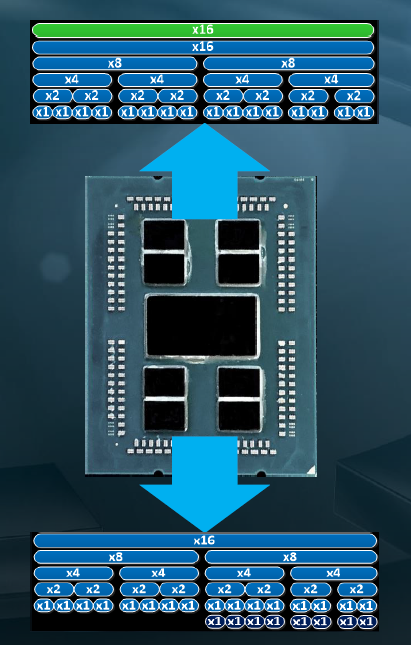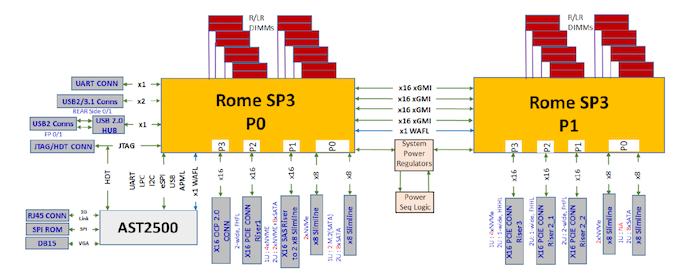AMD Rome Second Generation EPYC Review: 2x 64-core Benchmarked
by Johan De Gelas on August 7, 2019 7:00 PM ESTPCIe 4.0
As the first commerical x86 server CPU supporting PCIe 4.0, the I/O capabilities of second generation EPYC servers are top of the class. One PCIe 4.0 x16 offers up to 32 GB/s in both direction, so each socket offers up to 256 GB/s in both directions, for a full 128 PCIe 4.0 lanes per CPU.
Each CPU has 8 x16 PCIe 4.0 links available which can be split up among up to 8 devices per PCIe root, as shown above. There is also full PCIe peer-to-peer support both within a single socket and across sockets.
With the previous generation, in order to enable a dual socket configuration, 64 PCIe lanes from each CPU were used to link them together. For EPYC, AMD still allows for 64 PCIe lanes to be used, but these are PCIe 4.0 lanes now. There is also another feature that AMD has here - socket-to-socket IF link bandwidth management - which allows OEM partners to design dual-socket systems with less socket-to-socket bandwidth and more PCIe lanes if needed.
We also learned that there are in fact 129 PCIe 4.0 lanes on each CPU. On each CPU there is one extra PCIe lane for the BMC (the chip that controls the server). Considering we are living in the age of AI acceleration, the EPYC 7002 servers will be great as hosts for quite a few GPUs or TPUs. Density has never looked so fun.












180 Comments
View All Comments
negusp - Wednesday, August 7, 2019 - link
hard F in the chat for intelpancakes - Wednesday, August 7, 2019 - link
F in chat for wallets of people running Windows serverazfacea - Wednesday, August 7, 2019 - link
windows server in 2019 LULdiehardmacfan - Wednesday, August 7, 2019 - link
on-prem Windows Server is probably at an all time high in 2019?azfacea - Thursday, August 8, 2019 - link
desperate for a comeback huh? cool hold your 10% tight and gloat about upcoming bfloat16diehardmacfan - Thursday, August 8, 2019 - link
Sorry, who is desperate for a comeback? Bring up a floating point format when called out on the ridiculous notion that Windows Server isn't still a large part of the marketplace? say whamkaibear - Thursday, August 8, 2019 - link
Just hopping in to say that I am an IT manager for a major employer in the UK and of our 1800 servers more than 80% of them are Windows... this is not a trend which I see changing any time soon.Deshi! - Thursday, August 8, 2019 - link
I work as an application engineer for a major global finance company that develops and hosts banking and e-commerce software used by banks and major shopping outlets. 90% of all our servers are either Linux or AIX mainly running websphere or standalone Java instances. We only have a handful of Windows servers, mainly for stuff like active directory and Outlook/ SharePoint. So yeah allot of it depends on the use case, but allot of the big boys do use Linux or AIX. It's cheaper and performs better for these use cases.cyberguyz - Thursday, August 8, 2019 - link
I guess we all have to ask ourselves, who are the customers that would benefit most from a 64-core, 128 gen 4 PCIe processors? SMB or huge customers that would shell out many millions of $$$ for their middleware & backend systems? @Deshi! I or one of my L3 colleagues an L3 engineer contacted by your global finance company to fix Websphere problems some years back ;)FreckledTrout - Thursday, August 8, 2019 - link
@cyberguz, Who would benefit from these high core servers? Any company running VM's so pretty much every large company. This goes doubly for cloud providers.